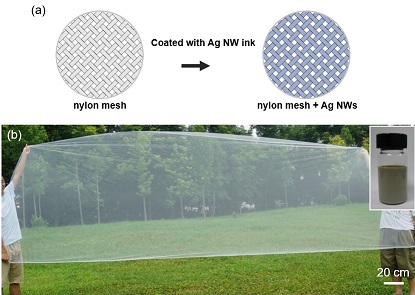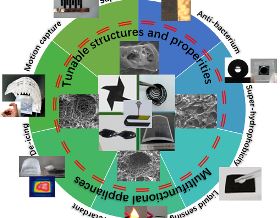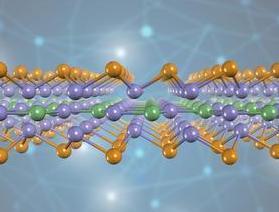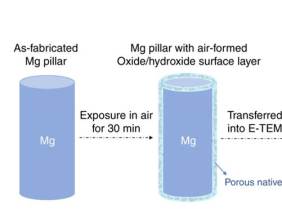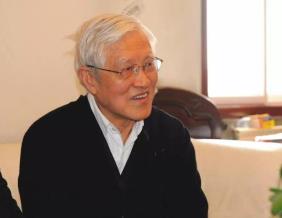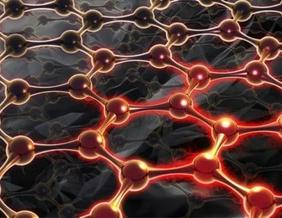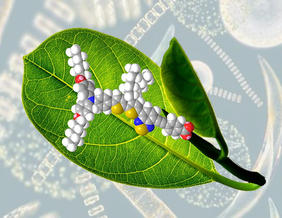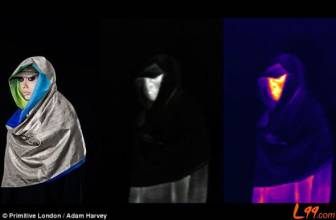
超构材料(metamaterial)是一类结构材料,它的新奇物理性质由材料的几何性质决定,这种材料在自然界或化合物中比较少见,它通常是由人工设计出来的。
研究回顾
这类材料在电磁学和光学领域已有大量的研究(例如入射光线与折射光线在法线同侧的负折射),相关的早期文献一般可以追溯到1968年Veselago的工作[1]。自上世纪90年代起,电磁学和光学领域关于超构材料的研究蓬勃发展、直到今天,仅在《Nature》、《Science》、《Physical Review Letters》这三个学术期刊上就已经发表大量学术论文。在此期间,Pendry及其合作者起到了引领作用,例如他们在2006年发表的一篇论文[2]引用次数已经达到2878次(2015年2月25日“web of science”检索结果);在此领域,近期也有数篇具有高影响力的论文,例如[3-6]。
当超构材料在电磁学和光学领域蓬勃发展之时,有学者把超构材料拓展到其它领域,例如声学[7]。至今,声学超构材料方面的研究也已达到白热化,具体进展可以参阅文献[8,9]。
波动方程与隐身衣
但是,无论是光学、电磁学、还是声学,这些领域都与“波”密切有关,或者说,在这些领域中,超构材料的新奇物理性质都是由波动方程确定的。这个事实致使很多科学家发展了大量的实验工具和理论方法,用于研究和操控波动方程。其中卓有成效的一个操控波动方程的理论方法就是基于坐标变换的方法,这个方法运用到电磁学或光学领域已取得极大成功,它给出了一个比较直观的便利途径,用于获得具有各种新奇性质的光学或电磁超构材料,例如光学隐身衣[2]——穿上这种隐身衣的人不能被外人看到。
正如上文所说,上述诸多材料都与波动方程有密切关系。鉴于波动方程与扩散方程的物理机制迥然不同,文献中对以扩散方程为主导的热学超构材料的研究非常缓慢。自2008年开始,有研究人员尝试了相关研究[10],他们基于热传导方程的坐标变换理论(即变换热学理论),设计了一类热学超构材料,理论预言了热隐身(thermal cloaking)等新奇的热学性质,为人工控制热流提供了一条迥然不同的思路; 2010年,研究人员基于胶体颗粒设计了一种热学隐身衣(图一、图二)[11]。

图一:图中R1和R2之间填充的是一种热学超构材料,它是基于胶体颗粒(右图黑点)设计的。这种材料具有热学隐身效果[11],参见图二。

图二:图一所示材料的温度分布效果(有限元模拟结果)[11]。此图呈现两个特点:(1)内圈里面温度均匀分布;(2)外圈之外的温度分布不受内外圈之间材料的影响。这两个特点直接导致,当内圈里面放置一个物体,外圈外面的观察者将无法通过探测外圈外面的温度分布而测得内圈里面的物体,所以,人们把该结构叫做热学隐身衣[10,11]。
具有这些新奇热学性质的热学超构材料[10,11],其后于2012年被美国哈佛大学的学者成功制备出来(图三)[12],并验证了论文[10,11]的理
论预言;除了论文[12],2012年起,热隐身以及热学超构材料的研究开始收到各国研究人员的密切关注,迄今,已经发表大量论文,例如
[9,13-37]。2008年的这篇论文[10]在此领域(即热学超构材料)的首创性被《Nature
Materials》文章明确点明[38];《Science》对此新领域也有专题新闻报道[39];2013年,美国麻省理工学院学者在
《Nature》发表一篇题为“Sound and heat revolutions in phononics
(声子学中声与热之革命)”的综述论文[40],论文中专门设有一个小节,标题为“Thermal metamaterials and heat
cloaking(热学超构材料与热隐身)”,介绍了这个新领域以及相关主要进展[10,12]。值得一提的是,《Nature》和《Science》还
分别发表一篇评论文章[41,42],这两篇文章对热隐身衣及热学超构材料的最新发展给出了很好的总结与展望。

图三:哈佛大学实验制备的热学隐身衣的温度分布[12]。图中内外圈之间填充的是热学超构材料,图二的图形说明中提及的两个特点在此图中皆有呈现,即:(1)内圈里面温度均匀分布;(2)外圈之外的温度分布(几乎)不受内外圈之间材料的影响。
热学超构材料制备
由于热学超构材料在实验制备时,对其微结构要求较高,所以,在制备时,具有结构可变性的软物质材料通常是重要的构件[11],自哈佛大学的工作[12]采用天然胶乳橡胶和硅橡胶开始,文献中在实验制备热学超构材料时,研究人员就对软物质材料青睐有加,例如聚二甲基硅氧烷[13]与聚苯乙烯[14]等软物质材料皆在实验制备热隐身衣(thermal cloak)时 被特别选用。这其中的物理机制与接触热阻有关。
具体解释如下:我们知道,两个宏观固体表面无论人工打磨得多么光滑,这两个固体表面贴合在一起时,中间总会存在或多或少的空气,从而导致热量从一个固体表面流向另一个固体表面时不能连续,也就是说,这时因为两个表面之间存在空气,它们之间会出现额外的热阻—— 这种“热阻”通常叫做“接触热阻”。显然,针对两个固体表面贴合在一起构成的空间而言,其接触热阻通常不为零,而两个软物质表面构成的空间,其接触热阻则 接近零——这是因为两个软物质表面(几乎)可以完全贴合在一起,从而排空两个表面之间的空气。类似地,一个软物质表面与一个固体表面结合在一起,基于同样的理由,这两个表面之间的接触热阻也能够接近零。以上分析正是文献中为什么通常选用软物质材料来设计热学超构材料的(主要)物理机制——接触热阻为零的直接好处就是给人们制备这类热学超构材料带来极大便利:人们可以根据理论方程的精确要求,选择符合条件的组元材料来设计热学超构材料,而不必额外考虑接触热阻对方程的影响(这个影响通常是不能预先精确控制的)。
可见,以上分析已经显示,实验制备[11-14]热学超构材料时,具有结构可变性质的软物质在其中起着至关重要的作用,所以,“热学超构材料”有时也可以叫做“软热学超构材料”,以彰显软物质在其中的关键作用。
两大特征
清晰起见,至此,可以把热学超构材料的特性归纳一下,这种材料是一种人造材料,从字面上看,其特征有二:
(1)“热学”—其宏观热学性质除了上文提及的热隐身效果,还有诸多新奇效果,例如高效聚集热流、热流反转(即热流表观上从低温流向高温)等。此外,还可以实现热流的任意旋转或热幻像效果。这里的热幻像是指通过设计热学超构材料,使得A物体(例如一个士兵)周围的温度斑图呈现出与B物体(例如一棵树)一样的分布规律,这样人们在通过红外探测温度斑图时将会把物体A(士兵)误以为物体B(树)。
(2)“超构”—这类材料的宏观热学性质主要由组成成份的几何性质(即微结构和尺寸大小)决定,而非由材料性质决定。
这种热学超构材料在热流控制领域(例如保温或散热)有着重要的潜在应用,科学家们正在为此努力。例如:通过设计热学隐身衣,可以使得人类居室四季如春,不受 寒暑交替的影响;这种材料还可以用于计算机芯片的高效散热,从而提高计算性能;此外,在军工方面也有潜在应用,例如可以用于实现热幻像,以便迷惑敌方的红外检测器。
参考文献
[1] V. G.Veselago, “The electrodynamics of substances with simultaneously negative valuesof ɛ and μ”, Soviet Physics Uspekhi 10, 509– 514 (1968)
[2] J. B.Pendry, D. Schurig, and D. R. Smith, “Controlling electromagnetic fields”, Science 312, 1780 (2006)
[3] A.Silva,F.Monticone,G.Castaldi,V.Galdi,A.Alu,, and N.Engheta,“Performing mathematical operations with metamaterials”, Science 343, 160 (2014)
[4] N. K.Grady,J. E.Heyes,D. R.Chowdhury,Y.Zeng,M. T.Reiten,A. K.Azad,A. J.Taylor,D. A. R.Dalvit,and H. T.Chen, “Terahertz metamaterials for linear polarization conversion and anomalous refraction”,Science 340, 1304 (2013)
[5] T.Xu,A.Agrawal,M.Abashin,K. J.Chau,and H. J.Lezec,“All-angle negative refraction and active flat lensing of ultraviolet light”, Nature 497, 470 (2013)
[6] A. V.Kildishev,A.Boltasseva,and V. M.Shalaev,“Planar photonics with metasurfaces”, Science 339,1232009 (2013)
[7] Z. Y. Liu, X. X. Zhang, Y. W.Mao, Y. Y. Zhu, Z. Y. Yang, C. T. Chan, and P. Sheng, “Locally resonant sonic materials”, Science 289, 1734 (2000)
[8]M. Wegener, “Metamaterials beyond optics”, Science 342, 939 (2013)
[9] M. Kadic, T. Bückmann, R. Schittny, and M. Wegener, “Metamaterials beyond electromagnetism”, Reports on Progress in Physics, 76, 126501 (2013).
[10] C. Z. Fan, Y. Gao, and J. P.Huang, “Shaped graded materials with an apparent negative thermal conductivity”, Applied Physics Letters, 92, 251907 (2008)
[13] R. Schittny, M. Kadic, S. Guenneau, and M. Wegener, “Experimentson transformation thermodynamics: Molding the flow of heat”, Physical ReviewLetters 110, 195901 (2013)
[14] T. C. Han, X. Bai, D. L. Gao, J. T. L. Thong, B. W. Li, andC.-W. Qiu, “Experimental demonstration of a bilayer thermal cloak”, Physical Review Letters 112, 054302 (2014)
[15] H.Y. Xu, X. H. Shi, F. Gao, H. D. Sun, and B. L. Zhang, “Ultrathin three-dimensional thermal cloak”, Physical Review Letters, 112, 054301 (2014)
[16] T. Han,X. Bai, J. T. L. Thong, B. Li, and C.-W. Qiu, “Full control and manipulation of heat signatures: Cloaking, camouflage and thermalmetamaterials”, Advanced Materials 26, 1731 (2014)
[17] S. Guenneau,C. Amra, and D. Veynante, “Transformation thermodynamics: cloaking and concentrating heat flux”, Optics Express, 20, 8207-8218 (2012)
[18] T. Han,T. Yuan, B. Li, and C. W. Qiu, “Homogeneous thermal cloak with constant conductivity and tunable heat localization”, Scientific Reports, 3, 1593 (2013)
[19] S. Narayana,S. Savo, and Y. Sato, “Transient heat flux shielding using thermal metamaterials”, Applied Physics Letters,102, 201904 (2013)
[20] Y.Ma, L. Lan, W. Jiang, F. Sun, and S. He, “A transient thermal cloak experimentally realized through a rescaled diffusion equation with anisotropic thermal diffusivity”, NPG Asia Materials, 5, e73 (2013)
[21] E.M. Dede, T. Nomura, P. Schmalenberg, and J. S. Lee, “Heat flux cloaking, focusing, and reversal in ultra-thin composites considering conduction-convection effects”, Applied Physics Letters, 103, 063501 (2013)
[22] T. Yang,L. Huang, F. Chen, and W. Xu, “Heat flux and temperature field cloaks forarbitrarily shaped objects”, Journal of Physics D, 46, 305102 (2013)
[23] X. Heand L. Wu, “Design of two-dimensional open cloaks with finite material parameters for thermodynamics”, Applied Physics Letters, 102, 211912 (2013)
[24] S. Guenneauand C. Amra, “Anisotropic conductivity rotates heat fluxes in transient regimes”, Optics Express, 21, 6578-6583 (2013)
[25] S. Muradand I. K. Puri, “Communication: a tractable design for a thermal transistor”, The Journal of Chemical Physics, 139, 151102 (2013)
[26] X. He and L. Wu, “Thermal transparency with the concept of neutral inclusion”, Physical Review E, 88, 033201 (2013)
[27] K. P. Vemuri and P. R. Bandaru, “Geometrical considerations in the control and manipulation of conductive heat flux in multilayered thermal metamaterials”, Applied PhysicsLetters, 103, 133111 (2013)
[28] T. Han, J. Zhao, T. Yuan, D. Y. Lei, B. Li, and C. W. Qiu, “Theoretical realization of an ultra-efficient thermal-energy harvesting cell made of natural materials”, Energy & Environmental Science, 6, 3537-3541 (2013)
[29] T. Chen, X. B. Wang, and J. Ren, “Dynamic control of quantum geometric heat flux in a nonequilibrium spin-boson model”, Physical Review B, 87, 144303 (2013)
[30] M. Maldovan,“Narrow low-frequency spectrum and heat management by thermocrystals”, PhysicalReview Letters, 110, 025902 (2013)
[31] Y. V.Kartashov, V. A. Vysloukh, and L. Torner, “Light dynamics in materials with radially inhomogeneous thermal conductivity”, Optics letters, 38, 4417-4420(2013)
[32] S. Fumeron, E. Pereira, and F. Moraes, “Modeling heat conduction in the presence of a dislocation”, International Journal of Thermal Sciences, 67, 64-71 (2013)
[33] Y. Gao and J. P. Huang, “Unconventional thermal cloak hiding an object outside the cloak”, EPL, 104, 44001 (2013)
[34]沈翔瀛、黄吉平,“热超构材料的研究进展”,物理,42,170(2013)
[35] Y. G. Ma, Y. C. Liu, M. Raza, Y. D. Wang, and S. L. He, “Experimental demonstration of a multiphysics cloak: Manipulating heat flux and electric current simultaneously”, Physical Review Letters 113, 205501 (2014)
[36] X. Y. Shen and J. P. Huang, “Thermally hiding an object inside a cloak with feeling”, International Journal of Heat and Mass Transfer 78, 1-6 (2014)
[37] M.Moccia, G. Castaldi, S. Savo, Y. Sato, and V. Galdi, “Independent manipulation of heat and electrical current via bifunctional metamaterials”, Physical ReviewX 4, 021025 (2014)
[38] P. Ball, “Material witness: Against the flow”, Nature Materials, 11, 566-566 (2012)
[39] J. Cartwright, “Heat trickery paves way for thermal computers”. http://news.sciencemag.org/2012/05/heat-trickery-paves-way-thermal-computers
[40] M. Maldovan, “Sound and heat revolutions in phononics”, Nature,503, 209-217 (2013).
[41] U.Leonhardt, “Cloaking of heat”, Nature, 498, 440-441 (2013)
[42] M. Wegener,“Metamaterials beyond optics”, Science, 342, 939-940 (2013)
(本文作者,复旦大学黄吉平老师,授权发布)
如若转载,请注明e科网。
如果你有好文章想发表or科研成果想展示推广,可以联系我们或免费注册拥有自己的主页
- 新材料
- 隐身衣
- 热学超构材料


 我要投稿
我要投稿




